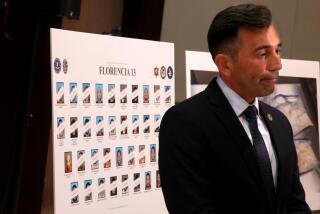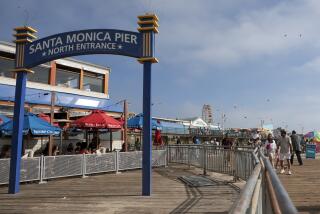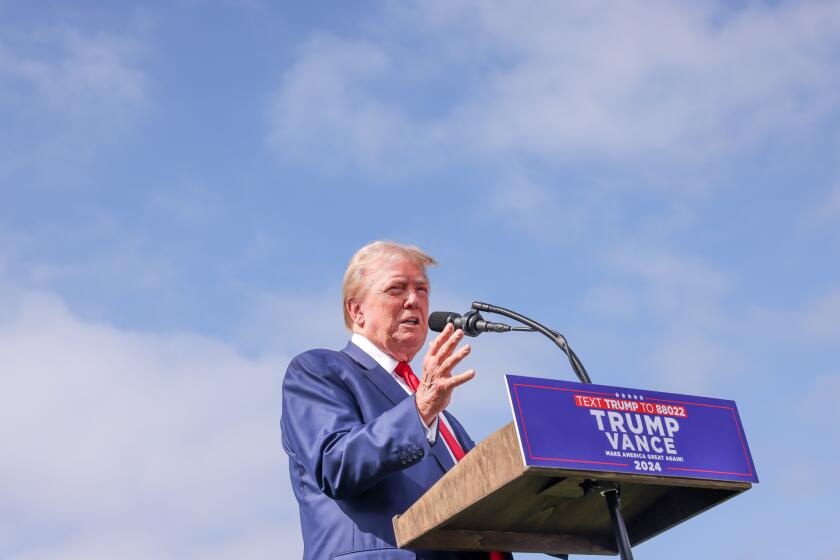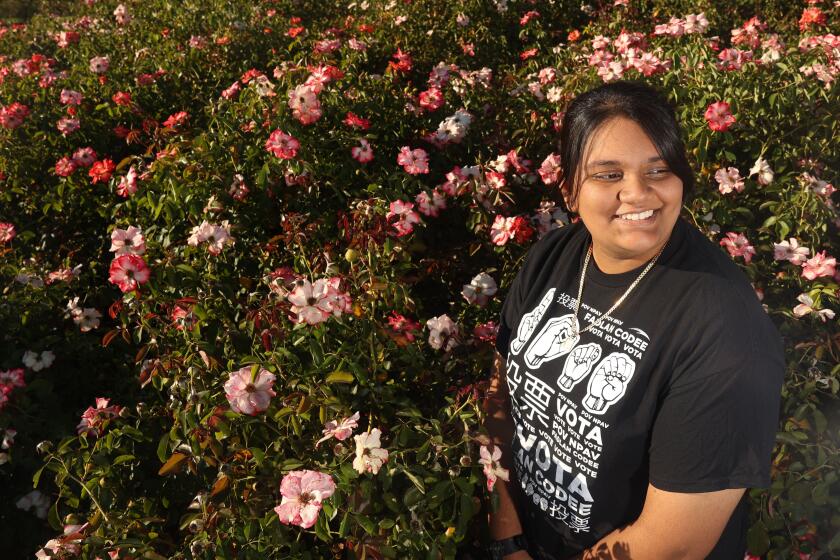Gang Bullets Pierce Santa Monica’s Image
William Henry Juarez grieved over the shooting deaths of his two sons in, of all places, Santa Monica, with its reputation as a city comfortably safe from the gang wars around it.
But despite its reputation, Juarez had seen the danger lurking in Santa Monica and nearby areas.
“I moved to [Cayucos in] San Luis Obispo [County] to get away from the violence,” he said, sitting in his mother’s apartment in Santa Monica. “My sons were wonderful boys, they were not affiliated with any gangs. My heart goes out to the shooters’ families. They don’t know the damage their children have caused our family.”
His sons, Michael, 27, and Anthony, 19, were killed Tuesday, becoming the latest victims in a string of retaliatory gang shootings in which four people have been slain in two weeks in the city. In addition, a German tourist was fatally shot in an unrelated attack outside an expensive beachfront hotel.
The unusual spate of violence--in a city that saw only one murder last year--has jolted residents and leaders alike who are accustomed to their town being in the spotlight for a beachfront lifestyle, chic restaurants and shops, affluent neighborhoods and liberal politics--not for bloody street violence.
City leaders, quick to protect Santa Monica’s image as a major tourist haven--are responding to the crisis by minimizing its impact on everyday life in the city.
“This is a war between two gangs, and they are looking for gang members and they are not interested in anyone else,” said Mayor Robert Holbrook. “What we’ve got is two gangs who are shooting at each other and we happen to be at one end of the battlefield.”
Gang experts say that the shootings are the latest in a long-running feud among two to four Westside gangs that have long terrorized pockets of Mar Vista, Venice and other areas of the Westside. This time, however, the turf wars have crossed the border of Santa Monica.
Juarez said he saw the violent clouds gathering years ago, prompting him to pack up and move his family to the quieter town up the coast.
Michael and Anthony were visiting their cousin at a clothing shop he partly owns when the shooting occurred. Michael wanted to open a similar store in Cayucos. Anthony, who had just graduated from high school, was attending a local community college and wanted to be a landscape architect.
“The shootings have got to stop,” sobbed Ginger Berg, Anthony’s mother. “Losing a child is my worst nightmare come true. It’s horrible. I hate guns.”
The rash of shootings in Santa Monica began Oct. 12 with the killing of tourist Horst Fietze, 50, of Loebau, Germany. He was shot, apparently by robbers, during a stroll with his wife and another couple near the Loews Santa Monica Beach Hotel.
That same day, police said, Omar Sevilla, 22, a member of a Culver City street gang, was shot to death near Santa Monica High School. He had been released from prison and was enrolled in a substance abuse program.
The next weekend, in what police say was gang retaliation for Sevilla’s death, gunfire killed one man and wounded another. Juan Martin Campos, a 28-year-old employee of the city of Santa Monica, was slain Oct. 17 as he tried to flee from two men who chased him into a liquor store. Javier Cruz, 25, was wounded Oct. 18 outside his home.
The wounding of Cruz, a Santa Monica College graduate who was attending UCLA, is the only recent Santa Monica shooting in which arrests have been made. Marcos Camarillo, 19, and Alex Acuna, 18, were booked on suspicion of attempted murder after being arrested at their homes in Culver City. Several firearms were recovered at the time of the arrests, police said.
The shootings of Michael and Anthony Juarez and the wounding of two others at the Westside clothing store fit the pattern of gang violence, said Santa Monica Police Chief James T. Butts Jr. The wounded, a customer and the store’s part owner, Frank Juarez, were taken to nearby hospitals. Their conditions were listed as good.
“The gunmen walked in and started shooting without asking for money,” Butts said. “We are very convinced that this is the work of a gang based in Culver City and Mar Vista who is acting out of retaliation against a Santa Monica gang.”
In response to the violence, the Santa Monica Police Department has has increased cooperative efforts with neighboring police agencies and leased a helicopter and will offer updates on gang-related incidents nightly at 6 p.m. on the city’s cable channel.
A multi-agency task force patrolling the streets Tuesday night arrested three gang members, one on suspicion of violating parole and two others on suspicion of involvement in a drive-by shooting earlier in the evening in which one person was wounded.
The Westside has long been home to at least five rival gangs, including the Culver City Boys and the Santa Monicas. Police suspect that Tuesday’s shooting was triggered by the death of Sevilla, a Culver City Boy, but no one has been able to determine why Sevilla was killed or by whom.
“No one has a reason,” said Lt. John Fletcher, the Westside anti-gang coordinator for the Los Angeles Police Department. “Whoever you talk to has a different opinion about what caused the first shooting, and of course, it was all retaliation from there.”
Fletcher and other authorities suspect that Sevilla could have been killed as a payback for some other altercation.
“There are attempts at truce negotiations,” said Lorenzo Merritt, executive director of Project Heavy West, an outreach group that counsels gang members, “but everyone is walking on eggshells.”
With its power base in the Mar Vista Gardens housing project, the Culver City Boys gang has long been tied to much of the gang-related bloodshed on the Westside.
Traditionally, the group has been the rival of the Latino gang in Venice. But after the two sides forged a truce in 1992, they began to go to war with the local black gang.
During the ensuing violence, which left at least 12 people dead and dozens of others wounded, the Culver City Boys were suspected of firebombing three Mar Vista Gardens units where African American families lived.
Federal authorities, in a 1995 racketeering case, alleged that the truce between the Culver City and Venice gangs, as well as some of the violence against African Americans, was orchestrated by Mexican Mafia prison gang members. The gang was attempting to control narcotics trafficking by street gangs on the Westside and other areas, prosecutors alleged.
Throughout the Pico neighborhood in Santa Monica on Wednesday, the mood was much more tense than usual.
On Delaware Avenue just off 17th Street, half a block from where Cruz was shot Oct. 18, five younger gang members didn’t want to discuss the feud in detail.
“This . . . been happening for years, but now people are dying,” said one.
Times staff writer Robert Lopez and correspondent Susan McAllister contributed to this story.
(BEGIN TEXT OF INFOBOX / INFOGRAPHIC)
Santa Monica Shootings
1. Oct. 12: Omar Sevilla, 22, killed, Pico Boulevard near 6th Street.
2. Oct. 12: Horst Fietze, 50, killed, 1600 block of Appian Way.
3. Oct. 17: Juan Martin Campos, 28, killed, 20th Street and Pico Boulevard.
4. Oct. 18: Javier Cruz, 25, wounded, 17th Street and Michigan Avenue.
5. Oct. 27: Michael Juarez, 27, and Anthony Juarez, 19, killed, two others wounded, 2200 block of Lincoln Boulevard.
More to Read
Sign up for Essential California
The most important California stories and recommendations in your inbox every morning.
You may occasionally receive promotional content from the Los Angeles Times.










